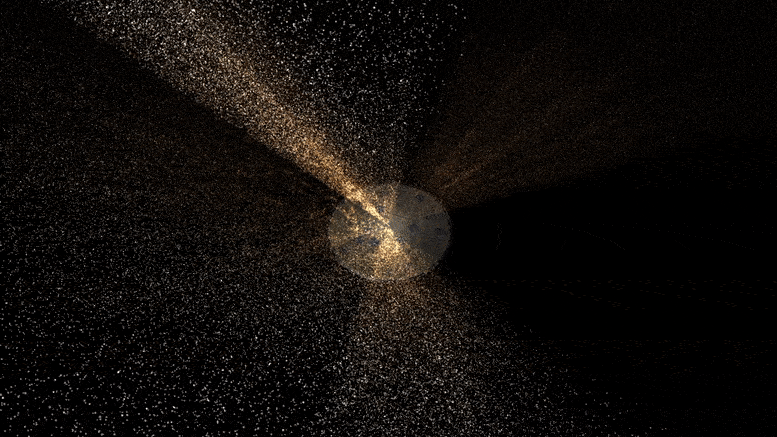
Astronomers used the Low-Frequency Array (LOFAR) to map over a quarter of the northern sky, revealing a detailed radio image of more than 4.4 million objects and a dynamic picture of our Universe, now publicly available for the first time.
A Durham University astronomer collaborating with a team of international scientists have mapped more than a quarter of the northern sky using the Low-Frequency Array (LOFAR), a pan-European radio telescope.
The map reveals an astonishingly detailed radio image of more than 4.4 million objects and a very dynamic picture of our Universe, which now has been made public for the first time.
The vast majority of these objects are billions of light-years away and are either galaxies that harbor massive black holes or are rapidly growing new stars. Rarer objects that have been discovered include colliding groups of distant galaxies and flaring stars within the Milky Way.
To produce the map, scientists deployed state-of-the-art data processing algorithms on high-performance computers all over Europe to process 3,500 hours of observations that occupy 8 petabytes of disk space — the equivalent to roughly 20,000 laptops.
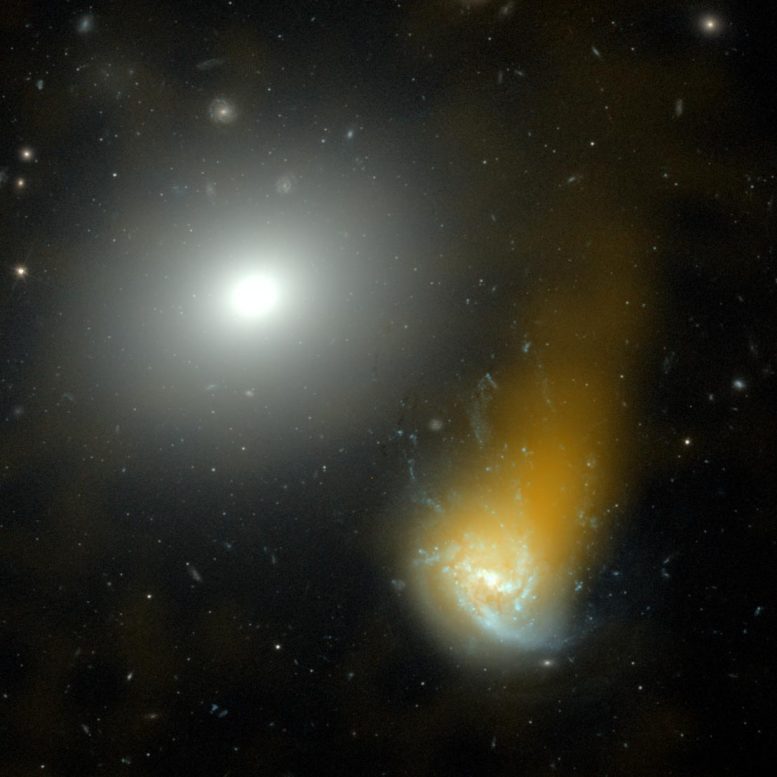
A composition radio (LoTSS-DR2) and optical (Hubble space telescope) image of the “jellyfish galaxy” NGC 4858 which is flying through a dense medium that is stripping material from the galaxy. Credit: Ian Roberts
This data release, which is by far the largest from the LOFAR Two-meter Sky Survey, presents about a million objects that have never been seen before with any telescope and almost four million objects that are new discoveries at radio wavelengths.
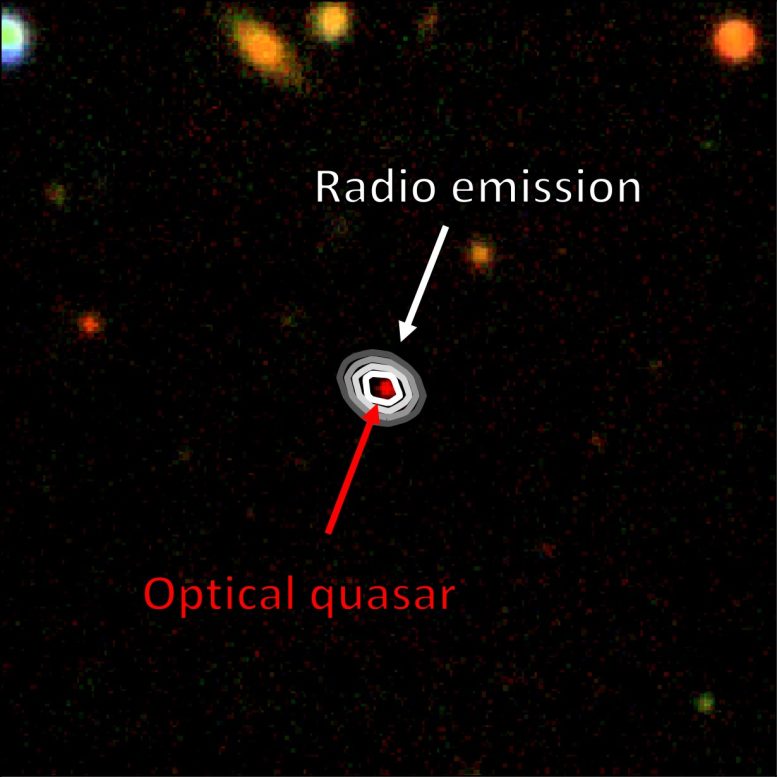
This innocuous looking red quasar is one of the most powerful objects in the early Universe and was formed within 1 billion years of the Big Bang. Here we see the quasar as it looked 12.9 billion years ago when its central black hole was rapidly accreting material and creating powerful outbursts that glow at radio wavelengths. We do not yet fully understand how such powerful sources formed so soon after the Big Bang. Credit: Anniek Gloudemans
Astronomer Timothy Shimwell of ASTRON and Leiden University, said: “This project is so exciting to work on. Each time we create a map our screens are filled with new discoveries and objects that have never before been seen by human eyes. Exploring the unfamiliar phenomena that glow in the energetic radio Universe is such an incredible experience and our team is thrilled to be able to release these maps publicly. This release is only 27% of the entire survey and we anticipate it will lead to many more scientific breakthroughs in the future, including examining how the largest structures in the Universe grow, how black holes form and evolve, the physics governing the formation of stars in distant galaxies and even detailing the most spectacular phases in the life of stars in our own Galaxy.”
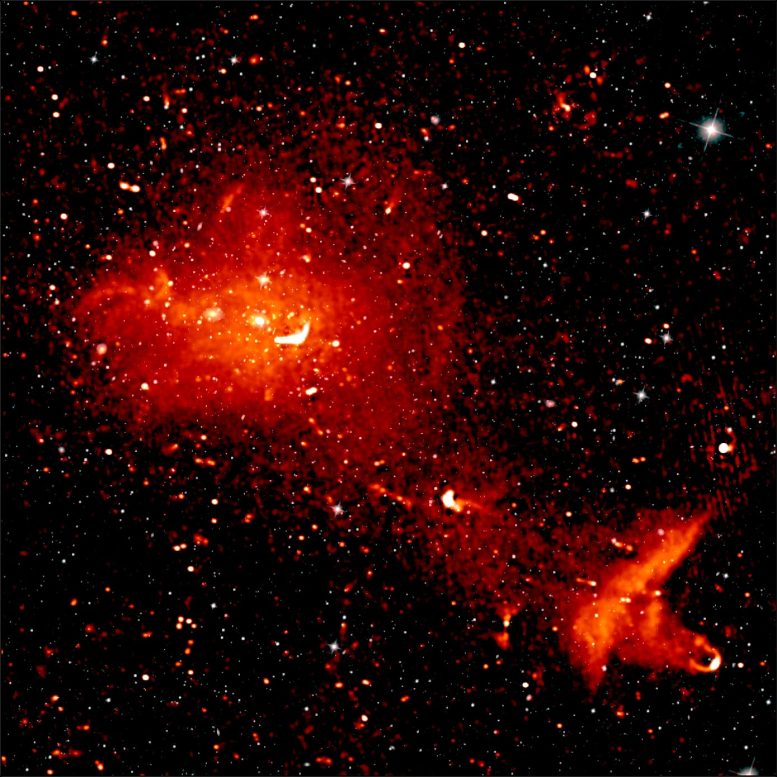
A composite radio (LoTSS; red) and infrared (WISE; white) image of the Coma cluster which is over 300 million light years from Earth and consists of over 1,000 individual galaxies. The radio image shows radiation from highly energetic particles that pervade the space between the galaxies. Credit: Annalisa Bonafede
Durham University scientist, Dr. Leah Morabito, said: “We’ve opened the door to new discoveries with this project, and future work will follow up these new discoveries in even more detail with techniques, which we work on here at Durham as part of the LOFAR-UK collaboration, to post-process the data with 20 times better resolution.”
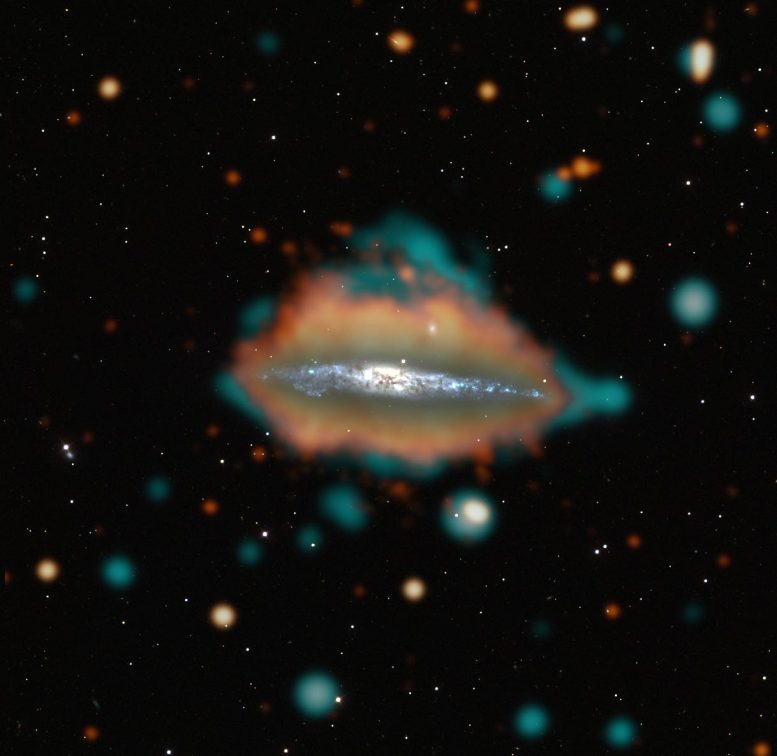
Radio, X-ray, and optical composite image of the “Whale Galaxy” NGC 4631. In this galaxy star-formation produces hot gas that is visible in X-ray (blue) as well as highly energetic particles that spiral in the galaxy’s magnetic field that are visible in the LoTSS radio image (orange). The high levels of star formation are possibly triggered by an interaction with a companion galaxy. Credit: Volker Heesen & Michael Stein
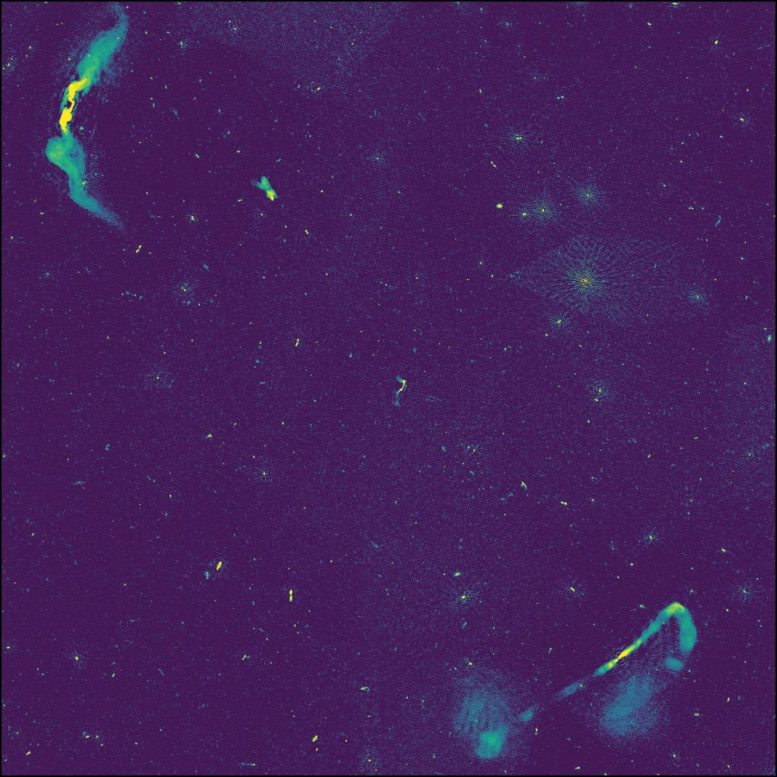
This image shows the dynamic highly energetic radio wavelength Universe. It is a 9 square degree cutout image of LoTSS-DR2 showing a region dominated by the radio galaxies NGC 315 and NGC 383 but containing about 7,000 other astronomical sources of radio radiation. The image covers an area that is 45 times larger than that of the full moon but corresponds to only 1.5% of the total amount of data released in LoTSS-DR2. Essentially all the objects that are visible lie in the distant Universe and are powerful, explosive phenomena such as jets of radiation from supermassive black holes and galaxies where stars are rapidly forming. Credit: Timothy Shimwell
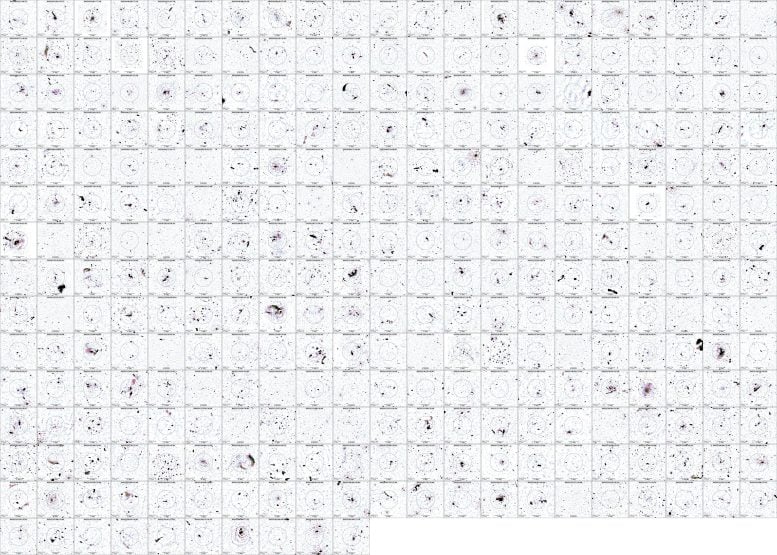
Each panel in this high resolution montage shows radio wavelength radiation produced when two giant clusters of 100s to 1000s of galaxies collide. These rare events are the most energetic since the big bang and produce gigantic shock waves and turbulence spanning millions of light years. The LoTSS-DR2 cluster survey has studied 309 galaxy clusters in the largest study of its kind and furthered our understanding of these highly energetic processes. Credit: Andrea Botteon
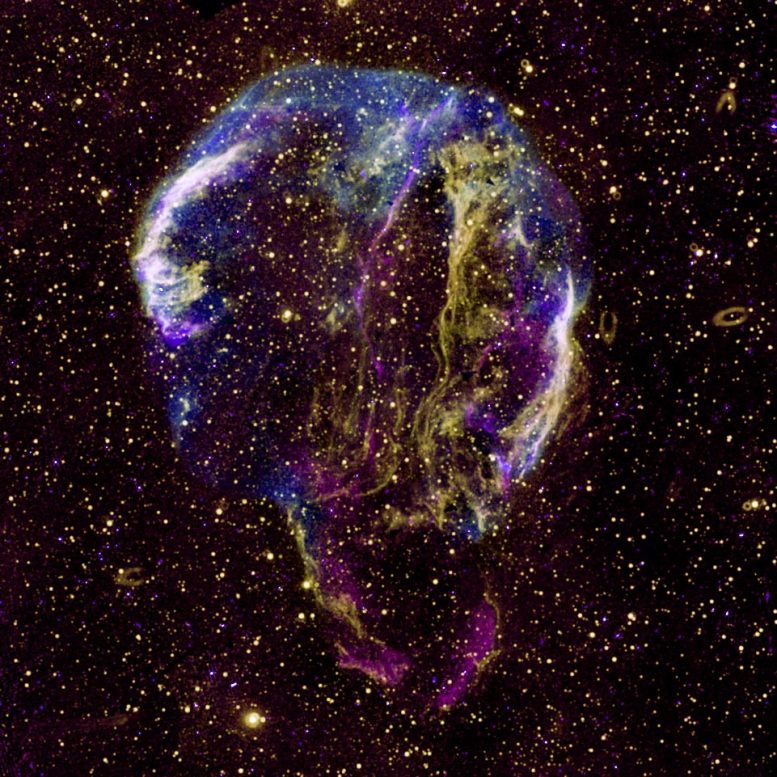
A composition radio (LoTSS; purple), UV (GALEX; yellow) and X-ray (ROSAT; blue) image of the Cygnus loop supernova remnant. This spectacular structure in the Milky Way is something to look forward to in future LoTSS data releases as the survey is now beginning to explore our Galaxy. Credit” Jennifer West
This data presents a major step forward in astrophysics and can be used to search for a wide range of signals, such as those from nearby planets or galaxies right through to faint signatures in the distant Universe.
Each dot in this animation shows the location of a hugely energetic object in our Universe. This includes black holes, galaxies with bursts of star formation, and explosive merging events between some of the Universe’s largest groups of galaxies. The animation shows the most detailed ever view of our radio Universe as revealed by LOFAR. Credit: Frits Sweijen
Reference: “The LOFAR Two-metre Sky Survey – V. Second data release” by T. W. Shimwell, M. J. Hardcastle, C. Tasse, P. N. Best, H. J. A. Röttgering, W. L. Williams, A. Botteon, A. Drabent, A. Mechev, A. Shulevski, R. J. van Weeren, L. Bester, M. Brüggen, G. Brunetti, J. R. Callingham, K. T. Chyzy, J. E. Conway, T. J. Dijkema, K. Duncan, F. de Gasperin, C. L. Hale, M. Haverkorn, B. Hugo, N. Jackson, M. Mevius, G. K. Miley, L. K. Morabito, R. Morganti, A. Offringa, J. B. R. Oonk, D. Rafferty, J. Sabater, D. J. B. Smith, D. J. Schwarz, O. Smirnov, S. P. O’Sullivan, H. Vedantham, G. J. White, J. G. Albert, L. Alegre, B. Asabere, D. J. Bacon, A. Bonafede, E. Bonnassieux, M. Brienza, M. Bilicki, M. Bonato, G. Calistro Rivera, R. Cassano, R. Cochrane, J. H. Croston, V. Cuciti, D. Dallacasa, A. Danezi, R. J. Dettmar, G. Di Gennaro, H. W. Edler, T. A. Enßlin, K. L. Emig, T. M. O. Franzen, C. García-Vergara, Y. G. Grange, G. Gürkan, M. Hajduk, G. Heald, V. Heesen, D. N. Hoang, M. Hoeft, C. Horellou, M. Iacobelli, M. Jamrozy, V. Jelic, R. Kondapally, P. Kukreti, M. Kunert-Bajraszewska, M. Magliocchetti, V. Mahatma, K. Malek, S. Mandal, F. Massaro, Z. Meyer-Zhao, B. Mingo, R. I. J. Mostert, D. G. Nair, S. J. Nakoneczny, B. Nikiel-Wroczynski, E. Orrú, U. Pajdosz-Smierciak, T. Pasini, I. Prandoni, H. E. van Piggelen, K. Rajpurohit, E. Retana-Montenegro, C. J. Riseley, A. Rowlinson, A. Saxena, C. Schrijvers, F. Sweijen, T. M. Siewert, R. Timmerman, M. Vaccari, J. Vink, J. L. West, A. Wolowska, X. Zhang and J. Zheng, 25 February 2022, Astronomy and Astrophysics.
DOI: 10.1051/0004-6361/202142484

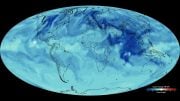







AWESOME
A couple trillion more and we’ll have a map of the universe.
Stupid music
Yes, maybe some trance would be more suited to stargazing. Brutal dubstep drops better for a spin class or something. Beautiful stars tho
“Whale Galaxy” NGC 4631 is the biggest pair of lips in the universe ,recalling the Cheshire czt’s grin.
Two trillion may be a serious undercount because each new measurement with better instruments reveals a much larger number from the previous one. And, that’s only the observable segment of the universe.
309 galaxy clusters each panel in this high resolution montage shows radio wavelength radiation produced when two giant clusters of 100s to 1000s of galaxies collide
Conspiracy theory number no309de breaking news
Take a galaxy cluster
Take any galaxy cluster of the 309 panel montage add any extra galaxy clusters not shown here but known from previous surveys
Its a conspiracy theory number no310de step one mark their right ascension
Its a conspiracy theory number no311de step two mark their declination
Its a conspiracy theory number no312de step three calculate their distance from milky way
From this data step four get a geometrician to draw the shape
Its a conspiracy theory number no313de step five these are the galactic highway junctions nodes ie galactic proper motion galaxy lanes of locomotion motorways
Its a conspiracy theory number no314de step six when you print this ill print my step six and seven
Its a conspiracy theory number no314de step six join the closest nodes together in a straight line relative to their distances from the milky way galaxy the high ways leading to the nodes roundabouts and flyovers then place a telescope and observe do you record this filamentary detail of such a geometrical construct and if you do volia a measurement of what size is observed between nodes and across the filament lengths
Its a conspiracy theory number no315de step seven how do all those galaxies get onto the highways where are they hiding in the side lanes and off ramps and side roads side lanes side boreens of the main highways leading to the galactic cluster nodes what size do you measure these at
Too bad their Radiotelescope was tuned to the Dubstep Channel…
Too bad their Radiotelescope was ‘tuned’ to the Dubstep Channel…
There ain’t any creator. It’s already there before the creation, and for it took alot of time randomly taking the form or shape of today’s universe so are we just randomly came into being and this is only the beginning of the human evolution. We die as we came to the life, and are not created bit formed from this suitable environment by evolution as the time passes by like the universe. Furthermore as I said it is just the beginning of the universe, therefore we are not the only life existing in this universe. There’s life out there and it’s just the beginning for the other life too. For discovering them by us vice versa takes time. Let’s give some billion years time to discover the real truth. When you know the creator humans will utterly be disappointing, I can guarantee that. 😂
Babu G. Ranganathan*
(B.A. Bible/Biology)
JUST BECAUSE SCIENCE CAN EXPLAIN how an airplane works doesn’t mean that no one designed or made the airplane. And just because science can explain how life or the universe works doesn’t mean there was no Designer and Maker behind them.
Natural laws may explain how the order in the universe works and operates, but mere undirected natural laws cannot explain the origin of that order. Once you have a complete and living cell then the genetic code and biological machinery exist to direct the formation of more cells from raw materials such as amino acids and other chemicals, but how could life or the cell have naturally originated when no directing code and mechanisms existed in nature? Read my Internet article: HOW FORENSIC SCIENCE REFUTES ATHEISM.
WHAT IS SCIENCE? Science simply is knowledge based on observation. No human observed the universe coming by chance or by design, by creation or by evolution. These are positions of faith. The issue is which faith the scientific evidence best supports.
SCIENCE SHOWS THAT THE UNIVERSE CANNOT BE ETERNAL because it could not have sustained itself eternally due to the law of entropy (increasing and irreversible net energy decay, even in an open system). Even a hypothetical oscillating universe could not continue to oscillate eternally! Einstein’s General Theory of Relativity shows that space, matter, and time all are physical and all had a beginning. Space even produces particles because it’s actually something, not nothing. What about the Higgs boson (the so-called “God Particle”)? The Higgs boson, even if it existed, would not have created mass from nothing, but rather it would have converted energy into mass. Einstein showed that all matter is some form of energy. Even time had a beginning! Time is not eternal.
The law of entropy doesn’t allow the universe to be eternal. If the universe were eternal, everything, including time and space (which modern science has shown are as physical as mass or matter), would have become totally entropied by now and the entire universe would have ended in a uniform heat death a long, long time ago. The fact that this hasn’t happened already is powerful evidence for a beginning to the universe.
Popular atheistic scientist Stephen Hawking admits that the universe had a beginning and came from nothing but he believes that nothing became something by a natural process yet to be discovered. That’s not rational thinking at all, and it also would be making the effect greater than its cause to say that nothing created something. The beginning had to be of supernatural origin because science teaches us from the First Law of Thermodynamics that natural laws and processes do not have the ability to bring something into existence from nothing.
The supernatural origin of the universe cannot be proved by science but science points to a supernatural intelligence and power for the origin and order of the universe. Where did God come from? Obviously, unlike the universe, God’s nature doesn’t require a beginning.
The disorder in the universe can be explained because of chance and random processes, but the order can be explained only because of intelligence and design.
Gravity may explain how the order found in the precise and orderly courses of thousands of billions of stars is maintained, but gravity cannot explain the origin of that order.
Some evolutionary astronomers believe that trillions of stars crashed into each other leaving surviving stars to find precise orderly orbits in space. Not only is this irrational, but if there was such a mass collision of stars then there would be a super mass residue of gas clouds in space to support this hypothesis. The present level of residue of gas clouds in space doesn’t support the magnitude of star deaths required for such a hypothesis. And, as already stated, the origin of stars cannot be explained by the Big Bang because of the reasons mentioned above. It’s one thing to say that stars may decay and die into random gas clouds, but it is totally different to say that gas clouds form into stars.
Even the father of Chaos theory admitted that the “mechanisms” existing in the non-living world allow for only very rudimentary levels of order to arise spontaneously (by chance), but not the kind or level of order we find in the structures of DNA, RNA, and proteins. Yes, individual amino acids have been shown to come into existence by chance but not protein molecules which require that the various amino acids be in a precise sequence just like the letters found in a sentence.
Some things don’t need experiment or scientific proof. In law there is a dictum called prima facie evidence. It means “evidence that speaks for itself.”
An example of a true prima facie would be if you discovered an elaborate sand castle on the beach. You don’t have to experiment to know that it came by design and not by the chance forces of wind and water.
If you discovered a romantic letter or message written in the sand, you don’t have to experiment to know that it was by design and not because a stick randomly carried by wind put it there. You naturally assume that an intelligent and rational being was responsible.
It’s interesting that Carl Sagan would have acknowledged sequential radio signals in space as evidence of intelligent life sending them, but he wouldn’t acknowledge the sequential structure of molecules in DNA (the genetic code) as evidence of an intelligent Cause. Read my popular Internet article, HOW DID MY DNA MAKE ME.
I encourage all to read my popular Internet articles:
NATURAL LIMITS TO EVOLUTION
HOW FORENSIC SCIENCE REFUTES ATHEISM
Visit my latest Internet site: THE SCIENCE SUPPORTING CREATION (This site answers many arguments, both old and new, that have been used by evolutionists to support their theory)
Author of popular Internet article, TRADITIONAL DOCTRINE OF HELL EVOLVED FROM GREEK ROOTS
*I have given successful lectures (with question and answer period afterwards) defending creation before evolutionist science faculty and students at various colleges and universities. I’ve been privileged to be recognized in the 24th edition of Marquis “Who’s Who in The East” for my writings on religion and science.
Your whole rambling argument looses all credence with the statement “Obviously, unlike the universe, God’s nature doesn’t require a beginning.” If you can accept that god doesn’t require a beginning, then you should be able to accept the universe doesn’t require external creation. If you believe god can just “be”, then so can the universe.
We can’t physically observe God whereas we can physically observe the universe. So we can’t apply science to God, but we can to the universe.
If you believe the universe can just ‘be'(physical) then again you go back and discredit science, as it can’t just be based on millenia of observation & laws. But if you believe God can just ‘be’, it’s not breaking any laws of science.
For something creating something physically is the most accurate explanation, which makes a God, or whatever else you’d like to call it, the most sensible explanation as to how the universe can be. So nah, believing God can just ‘be’ and the Universe can just ‘be’ are not comparable. The laws of science only apply to what scientists may observe.